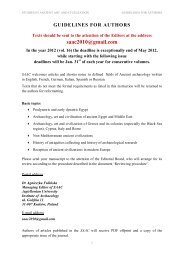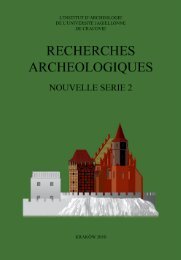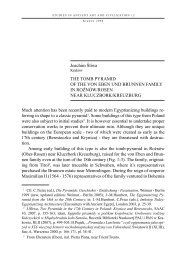l'institut d'archeologie de l'universite jagellonne de cracovie ...
l'institut d'archeologie de l'universite jagellonne de cracovie ...
l'institut d'archeologie de l'universite jagellonne de cracovie ...
Create successful ePaper yourself
Turn your PDF publications into a flip-book with our unique Google optimized e-Paper software.
Excavations of the Western Kom at Tell<br />
el-Farkha began in 2006 on 11th February<br />
and came to a close on 4th March. The<br />
main aim of this season’s campaign was to<br />
clean the surface before the geophysical research,<br />
which were realized on 31th March.<br />
It was the main reason, that the new trench<br />
<strong>de</strong>limited on the Western Kom covered more<br />
than 14 are (1400 m 2 ). On the whole surface<br />
upper layers were seriously <strong>de</strong>stroyed by<br />
animals as well as human activity. Numerous<br />
pits and dumps caused that archaeological<br />
materials were mixed and it was necessary<br />
to clean the surface layers to the <strong>de</strong>pth<br />
of 20 – 40 cm.<br />
Because we were excavating on the slope<br />
the differences between the highest part of<br />
the hill and the lowest one were nearly 2 m<br />
(between 738–549 cm a.s.l.) and from the<br />
beginning we had been excavating various<br />
chronological and cultural layers.<br />
The Western Kom at Tell el-Farkha was<br />
abandoned at the beginning of the I dynasty,<br />
as the first of Koms which form the site.<br />
The Central and the Eastern tells were occupied<br />
till the beginning of the IV dynasty,<br />
i.e. about 250 years longer (Chłodnicki,<br />
Ciałowicz 2003, 73 ff.). The layers from<br />
the top of the hill, excavated during season<br />
2006 were connected with the period<br />
of Dynasty 0 and I. Layers excavated at the<br />
lower southern edge of the Kom were very<br />
damaged by a mo<strong>de</strong>rn rubbish heap, nevertheless<br />
they should be connected probably<br />
Krzysztof M. Ciałowicz<br />
Recherches Archéologiques<br />
SN 1, 2009, 429 – 455<br />
ISSN 0137 – 3285<br />
Excavations of the Western Kom at Tell el-Farkha in 2006<br />
with Naqada III (A-B?) culture. In the next<br />
season the chronological position of these<br />
layers should be fixed.<br />
The main and most important discoveries<br />
ma<strong>de</strong> during this season were connected<br />
with layers dated to the beginning of Dynasty<br />
I. In the area to the west of the old<br />
trench, in the north-western corner (are<br />
53) of the newly <strong>de</strong>limited excavation area<br />
a rectangular <strong>de</strong>bris of walls was discovered.<br />
The space was surroun<strong>de</strong>d by 45 cm<br />
thick brick walls (1,5 of a brick), it was oriented<br />
along the NW-SE axis and the room<br />
measured 8×3.30 m (Fig. 1). It is worth to<br />
stress that the <strong>de</strong>scribed room is evi<strong>de</strong>ntly<br />
connected with the great building – socalled<br />
administrative-cultic centre – found<br />
on the same level in 2001, when the trench<br />
finished in 2005 was excavated. The most<br />
important discovery ma<strong>de</strong> at that time was a<br />
small <strong>de</strong>posit of miniature pottery and stone<br />
vessels, figurines of baboons, a crocodile<br />
and a prostrate man as well as 5 clay rattles<br />
(comp. Ciałowicz 2006). These first <strong>de</strong>posit<br />
was uncovered within massive walls marking<br />
off a relatively small room that was a<br />
part of the building of a consi<strong>de</strong>rable size<br />
(at least 25 by 15 m), ma<strong>de</strong> up of a series<br />
of rooms.<br />
In the middle of the mentioned room discovered<br />
in 2006 a concentration of 8 vessels<br />
was found (Fig. 2). The special interest was<br />
put on: the so-called Nubian vessel – a bowl<br />
<strong>de</strong>corated with punctured dots and incised





